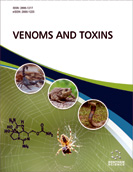Abstract
Background: The World Health Organization added snakebite envenoming to its priority list of neglected tropical diseases. Snakebite envenoming is a particularly important public health problem in rural areas of tropical and sub-tropical countries. In 2017, more than 30 thousand cases of snakebites were reported in Brazil, with the North and Northeast regions being the most affected and Bothrops sp snakes causing most of these cases.
Objective: The objective of this study was to evaluate, in vitro, the coagulating, cytotoxic, oxidizing and antioxidant effects caused by Bothrops jararacussu and B. moojeni crude venoms. Methods: The crude venoms protein profiles were characterized, and the biological effects were evaluated and compared between the species. Results: The crude venoms composition showed similar protein profiles. The B. jararacussu and B. moojeni crude venoms showed coagulant activity and were capable of causing indirect hemolysis on the erythrocyte membrane, but did not protect the erythrocyte membrane from damage against hypotonic solutions. The B. jararacussu crude venom promoted hemagglutination. Conclusion: The crude venoms were not able to promote an oxidizing effect on hemoglobin and could not prevent the phenylhydrazine oxidizing effect; however, the crude venoms presence caused increase in the methemoglobin formation by phenylhydrazine oxidation.Keywords: Snake venom, coagulating effect, hemolytic activity, oxidative stress, antioxidant effect, phenylhydrazine oxidation.
Graphical Abstract
[http://dx.doi.org/10.1186/s40409-017-0127-6] [PMID: 28804495]
[http://dx.doi.org/10.1016/S0041-0101(98)00126-3] [PMID: 9839663]
[http://dx.doi.org/10.1586/14789450.5.6.787] [PMID: 19086859]
[http://dx.doi.org/10.1016/S0041-0101(01)00146-5] [PMID: 11600146]
[http://dx.doi.org/10.1016/j.cbpc.2007.09.001] [PMID: 17933591]
[http://dx.doi.org/10.1016/j.toxicon.2009.01.039] [PMID: 19303034]
[http://dx.doi.org/10.1016/S0140-6736(09)61754-2] [PMID: 20109866]
[http://dx.doi.org/10.1016/0041-0101(91)90116-9] [PMID: 1814005]
[http://dx.doi.org/10.1016/j.toxicon.2006.06.005] [PMID: 16889808]
[http://dx.doi.org/10.1016/j.jprot.2009.01.005] [PMID: 19457355]
[http://dx.doi.org/10.1021/pr060494k] [PMID: 17203976]
[http://dx.doi.org/10.3791/1610] [PMID: 19890248]
[http://dx.doi.org/10.1038/227680a0] [PMID: 5432063]
[PMID: 3273606]
[http://dx.doi.org/10.1016/j.toxlet.2017.08.020] [PMID: 28847519]
[http://dx.doi.org/10.1016/S0925-4439(97)00013-6] [PMID: 9247087]
[PMID: 4782558]
[http://dx.doi.org/10.1590/S1516-84842004000100004]
[http://dx.doi.org/10.1016/j.nutres.2008.04.004] [PMID: 19083446]
[http://dx.doi.org/10.1111/j.1476-4431.2009.00389.x] [PMID: 19691581]
[http://dx.doi.org/10.1016/j.biochi.2004.02.002] [PMID: 15134836]
[http://dx.doi.org/10.1016/S1388-1981(00)00110-4] [PMID: 11080677]
[http://dx.doi.org/10.1016/S0300-9084(00)01168-8] [PMID: 11086212]
[http://dx.doi.org/10.1016/0041-0101(88)90244-9] [PMID: 3176051]
[http://dx.doi.org/10.1590/S0100-879X1998000900004] [PMID: 9876278]
[http://dx.doi.org/10.1007/BF01024915] [PMID: 8427634]
[http://dx.doi.org/10.1016/S0300-9084(00)01150-0] [PMID: 11018293]
[http://dx.doi.org/10.1016/S0006-2952(02)01210-8] [PMID: 12167491]
[http://dx.doi.org/10.1016/j.biochi.2003.09.011] [PMID: 14644553]
[http://dx.doi.org/10.1371/journal.pntd.0002442] [PMID: 24069493]
[http://dx.doi.org/10.1016/j.toxicon.2008.10.014] [PMID: 18948130]
[http://dx.doi.org/10.1080/15216549800201992]
[http://dx.doi.org/10.1023/A:1014131115951] [PMID: 11902666]
[http://dx.doi.org/10.1371/journal.pone.0120514] [PMID: 25811661]
[http://dx.doi.org/10.1016/j.toxicon.2016.12.007] [PMID: 28003128]
[http://dx.doi.org/10.1016/S0041-0101(02)00140-X] [PMID: 12220716]
[http://dx.doi.org/10.1016/j.toxicon.2007.02.018] [PMID: 17433397]
[http://dx.doi.org/10.1016/j.biochi.2007.10.005] [PMID: 17996740]
[http://dx.doi.org/10.1016/j.cbpa.2007.02.036]
[http://dx.doi.org/10.1016/0041-0101(96)00006-2] [PMID: 8843581]
[http://dx.doi.org/10.1016/j.peptides.2007.10.010] [PMID: 18006118]
[http://dx.doi.org/10.1107/S1744309111054923] [PMID: 22298002]
[http://dx.doi.org/10.1016/j.ijbiomac.2017.05.025] [PMID: 28495622]
[http://dx.doi.org/10.1016/j.toxicon.2004.06.002] [PMID: 15246772]
[http://dx.doi.org/10.1016/j.jmgm.2006.09.010] [PMID: 17081786]
[http://dx.doi.org/10.1016/j.toxicon.2017.10.025] [PMID: 29107670]
[http://dx.doi.org/10.1006/abbi.1999.1492] [PMID: 10620318]
[http://dx.doi.org/10.1016/S0041-0101(97)00133-5] [PMID: 9637370]
[http://dx.doi.org/10.1590/S1678-91992011000100007]
[http://dx.doi.org/10.1016/j.toxicon.2008.08.020] [PMID: 18929590]
[http://dx.doi.org/10.1016/j.jpba.2012.04.008] [PMID: 22571953]
[http://dx.doi.org/10.1016/j.toxicon.2008.03.030] [PMID: 18501940]
[http://dx.doi.org/10.1016/0041-0101(93)90182-I] [PMID: 8503135]
[http://dx.doi.org/10.1590/S1678-91992010000300016]
[http://dx.doi.org/10.1155/2014/920942] [PMID: 24971359]
[http://dx.doi.org/10.1080/15216549900202193] [PMID: 10410253]
[http://dx.doi.org/10.1016/j.toxicon.2016.01.055] [PMID: 26797102]
[http://dx.doi.org/10.1016/0041-0101(85)90374-5] [PMID: 3933145]
[http://dx.doi.org/10.1016/j.toxicon.2007.11.017] [PMID: 18187176]
[http://dx.doi.org/10.1016/j.toxicon.2008.10.007] [PMID: 19000915]
[http://dx.doi.org/10.5402/2012/673941] [PMID: 23762636]
[http://dx.doi.org/10.1155/2014/352420] [PMID: 24982866]
[http://dx.doi.org/10.1111/j.1742-4658.2008.06466.x] [PMID: 18479462]
[http://dx.doi.org/10.1016/j.ijbiomac.2007.01.006] [PMID: 17320169]
[http://dx.doi.org/10.1016/0041-0101(93)90183-J] [PMID: 8503136]
[http://dx.doi.org/10.1016/j.toxicon.2012.08.017] [PMID: 22975266]
[http://dx.doi.org/10.1007/s00204-015-1533-6] [PMID: 26026608]
[http://dx.doi.org/10.1016/j.toxicon.2003.10.010] [PMID: 14757212]
[http://dx.doi.org/10.1016/S0041-0101(99)00236-6] [PMID: 10758277]
[PMID: 12458635]
[http://dx.doi.org/10.1007/s00018-003-3325-z] [PMID: 15095007]
[http://dx.doi.org/10.3390/toxins10100411] [PMID: 30314373]
[http://dx.doi.org/10.3390/toxins11020094] [PMID: 30736322]
[http://dx.doi.org/10.1097/MBC.0000000000000577] [PMID: 27314863]
[http://dx.doi.org/10.1016/j.cbpa.2005.12.033] [PMID: 16481207]
[http://dx.doi.org/10.1016/j.toxicon.2010.05.012] [PMID: 20677373]
[http://dx.doi.org/10.1016/j.toxicon.2003.11.002] [PMID: 15019485]
[http://dx.doi.org/10.1016/j.bbapap.2014.09.015] [PMID: 25278377]
[http://dx.doi.org/10.1002/jcb.22148] [PMID: 19455508]
[http://dx.doi.org/10.1590/S0103-84782004000200012]
[http://dx.doi.org/10.1016/j.febslet.2006.02.006] [PMID: 16497300]
[http://dx.doi.org/10.1093/abbs/gmr003] [PMID: 21297119]
[http://dx.doi.org/10.1097/00000542-200111000-00041] [PMID: 11685006]
[http://dx.doi.org/10.1016/j.toxicon.2015.02.014] [PMID: 25727382]
[http://dx.doi.org/10.3390/toxins10120539] [PMID: 30558289]
[http://dx.doi.org/10.1186/s40409-017-0114-y] [PMID: 28439287]
[http://dx.doi.org/10.1016/j.biochi.2008.12.004] [PMID: 19135502]
[http://dx.doi.org/10.1016/j.bbagen.2011.04.003] [PMID: 21539897]
[PMID: 12621545]
[http://dx.doi.org/10.1016/j.toxicon.2012.05.001] [PMID: 22579637]
[http://dx.doi.org/10.1016/j.toxicon.2012.09.009] [PMID: 23010165]
[http://dx.doi.org/10.1007/s10616-014-9752-x] [PMID: 25149285]
[PMID: 5452]
[http://dx.doi.org/10.1021/bi00648a036] [PMID: 175827]
[PMID: 7663379]
 16
16 1
1

